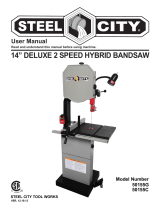Draper 200mm Bandsaw Operating instructions
- Type
- Operating instructions
This manual is also suitable for
Draper 200mm Bandsaw is a versatile power tool designed to make precise cuts in wood, wood-based materials, and plastics. With a powerful 250W motor and a maximum cutting depth of 80mm, it's ideal for a variety of projects, from intricate woodworking to DIY tasks. It features a sturdy construction, adjustable table and blade guides, and a no-volt release switch for enhanced safety. Additionally, the dust extraction outlet allows for a cleaner working environment.
Draper 200mm Bandsaw is a versatile power tool designed to make precise cuts in wood, wood-based materials, and plastics. With a powerful 250W motor and a maximum cutting depth of 80mm, it's ideal for a variety of projects, from intricate woodworking to DIY tasks. It features a sturdy construction, adjustable table and blade guides, and a no-volt release switch for enhanced safety. Additionally, the dust extraction outlet allows for a cleaner working environment.




















-
 1
1
-
 2
2
-
 3
3
-
 4
4
-
 5
5
-
 6
6
-
 7
7
-
 8
8
-
 9
9
-
 10
10
-
 11
11
-
 12
12
-
 13
13
-
 14
14
-
 15
15
-
 16
16
-
 17
17
-
 18
18
-
 19
19
-
 20
20
-
 21
21
-
 22
22
-
 23
23
-
 24
24
Draper 200mm Bandsaw Operating instructions
- Type
- Operating instructions
- This manual is also suitable for
Draper 200mm Bandsaw is a versatile power tool designed to make precise cuts in wood, wood-based materials, and plastics. With a powerful 250W motor and a maximum cutting depth of 80mm, it's ideal for a variety of projects, from intricate woodworking to DIY tasks. It features a sturdy construction, adjustable table and blade guides, and a no-volt release switch for enhanced safety. Additionally, the dust extraction outlet allows for a cleaner working environment.
Ask a question and I''ll find the answer in the document
Finding information in a document is now easier with AI
Related papers
-
Draper Bandsaw Operating instructions
-
Draper 405mm Variable Speed Fretsaw Operating instructions
-
Draper 35mm Capacity Plastic Pipe or Moulding Cutter Operating instructions
-
Draper 250mm Bandsaw Operating instructions
-
Draper NEW Bandsaw, 305mm, 750W Operating instructions
-
Draper NEW Bandsaw, 340mm, 1100W Operating instructions
-
Draper Metal Cutting Horizontal Bandsaw, 260mm, 1100W Operating instructions
-
Draper 130mm Horizontal Metal Cutting Bandsaw Operating instructions
-
Draper 150mm Horizontal/Vertical Metal Cutting Bandsaw Operating instructions
-
Draper Grass Trimmer Operating instructions
Other documents
-
Grizzly G4818 Owner's manual
-
Hilti SB 4-A22 Operating instructions
-
Clarke CBS-12WB Owner's manual
-
Parkside PBS 350 A1 Operating And Safety Instructions Manual
-
Workzone WWPBS-18 User manual
-
Total TS730301 Owner's manual
-
 Steel City 50155G User manual
Steel City 50155G User manual
-
Clarke Woodworker CBS 355 Specification
-
Rikon Power Tools 10-306 User manual
-
Rikon Power Tools 10-3061 User manual
























